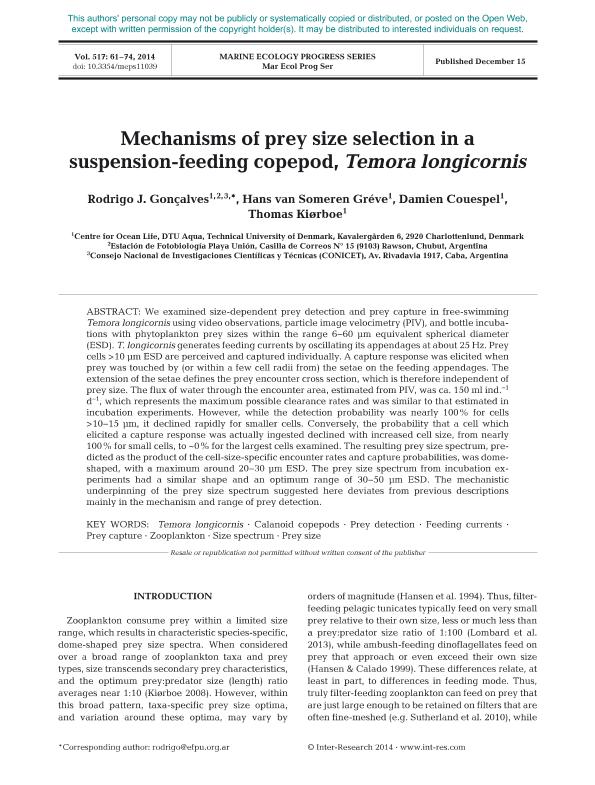Artículo
Mechanisms of prey size selecon in a suspension feeding copepod, Temora longicornis
Fecha de publicación:
15/12/2014
Editorial:
Inter-research
Revista:
Marine Ecology Progress Series
ISSN:
0171-8630
e-ISSN:
1616-1599
Idioma:
Inglés
Tipo de recurso:
Artículo publicado
Clasificación temática:
Resumen
We examined size-dependent prey detection and prey capture in free-swimming Temora longicornis using video observations, particle image velocimetry (PIV), and bottle incubations with phytoplankton prey sizes within the range 6-60 µm equivalent spherical diameter (ESD). T. longicornis generates feeding currents by oscillating its appendages at about 25 Hz. Prey cells >10 µm ESD are perceived and captured individually. A capture response was elicited when prey was touched by (or within a few cell radii from) the setae on the feeding appendages. The extension of the setae defines the prey encounter cross section, which is therefore independent of prey size. The flux of water through the encounter area, estimated from PIV, was ca. 150 ml ind.-1 d-1, which represents the maximum possible clearance rates and was similar to that estimated in incubation experiments. However, while the detection probability was nearly 100% for cells >10-15 µm, it declined rapidly for smaller cells. Conversely, the probability that a cell which elicited a capture response was actually ingested declined with increased cell size, from nearly 100% for small cells, to ~0% for the largest cells examined. The resulting prey size spectrum, predicted as the product of the cell-size-specific encounter rates and capture probabilities, was dome-shaped, with a maximum around 20-30 µm ESD. The prey size spectrum from incubation experiments had a similar shape and an optimum range of 30-50 µm ESD. The mechanistic underpinning of the prey size spectrum suggested here deviates from previous descriptions mainly in the mechanism and range of prey detection.
Archivos asociados
Licencia
Identificadores
Colecciones
Articulos(CCT-CENPAT)
Articulos de CTRO.CIENTIFICO TECNOL.CONICET - CENPAT
Articulos de CTRO.CIENTIFICO TECNOL.CONICET - CENPAT
Citación
Gonçalves, Rodrigo Javier; van Someren Gréve, Hans; Couespel, Damien; Kiørboe, Thomas; Mechanisms of prey size selecon in a suspension feeding copepod, Temora longicornis; Inter-research; Marine Ecology Progress Series; 517; 15-12-2014; 61-74
Compartir
Altmétricas




